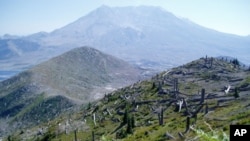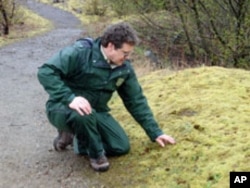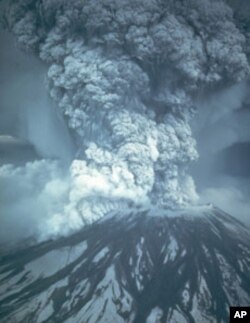On May 18, 1980, Mount St. Helens in Washington State erupted with a force that killed 57 people, destroyed 52,000 hectares of forest, and sent an ash plume so high it circled the globe. Now, three decades later, the blast zone is once again teeming with life, amazing scientists.
Peter Frenzen was a university student when the mountain blew. In Seattle, 150 kilometers from the volcano, he watched the devastation unfold on TV. Today, Frenzen is the staff scientist for the Mount St. Helens National Volcanic Monument. The park preserves portions of the blast zone for scientific studies. Other parts are open for public recreation.
From charred landscape to new life
Bucolic trails wind through the once charred landscape surrounding Mount St. Helens. Tall alders grow around ponds that weren't here before. Multitudes of frogs and salamanders will appear soon as it warms up. Elk hoof prints cross the way. Willows and lupines sprout on exposed hillsides.
"The change has been amazing," Frenzen says. "And one of things that we've learned here at Mount St. Helens is that things that initially look dead are usually anything but dead. Those things that look messy to our eye are in fact the critical ingredients of the next thriving ecosystem.
Like Frenzen, Washington State University botanist John Bishop has also spent much of his professional career in the blast zone.
"What we've realized as we've spent a lot of time here and we've quantified the plants and the animals is that we actually have extraordinary levels of diversity here, of biological diversity," says Bishop.
There is more richness around the volcano now, in fact, than in an old growth forest. The patchy jumble of habitats has become a stronghold for critters otherwise in decline such as elk, the yellow warbler and Western toad.
Letting nature take its course
Bishop suggests there are lessons to be learned from watching nature take its course.
"This recognition might lead us to be more careful as we decide what to do with disturbed areas," he says. "So it could be applied to areas that have experienced large forest fires, for example."
Frenzen admits it's not as productive in terms of lumber or other material. "But in terms of the animals and plants out here, it's fundamentally more productive in terms of the diversity of the ecosystem that results."
He says the human tendency is to rush in and restore or replant things. But after watching the developments on the slopes of Mount St. Helens, he and his colleagues have become believers in letting nature run its course, at least some of the time.
Wider implications
Forest Service researcher Charlie Chrisafulli and seven other scientists published a journal article to that effect this spring. It's the latest in a flurry of recent papers that try to draw wider implications from the explosion of new life at the volcano.
In addition to recovery after wildfires, Chrisafulli sees applications for other restoration situations. "Areas that were inundated following tsunamis, or from windstorms and ice storms and even from harvesting practices or strip mines."
In fact, Chrisafulli says U.S. mining industry consultants called him recently for ideas about restoring the scraped, barren landscape around closed strip mines.
He told them to plant lupines because those flowers have done such a good job of creating new soil at the volcano.








